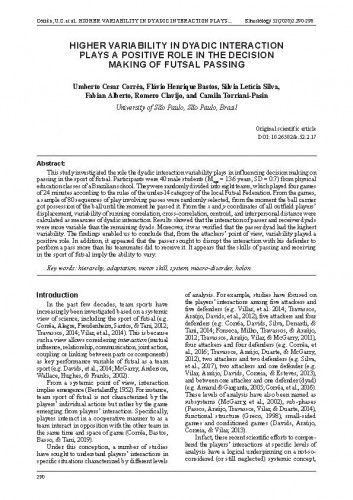This study investigated the role the dyadic interaction variability plays in influencing decision making on passing in the sport of futsal. Participants were 40 male students (Mage = 13.6 years, SD = 0.7) from physical education classes of a Brazilian school. They were randomly divided into eight teams, which played four games of 24 minutes according to the rules of the under-14 category of the local Futsal Federation. From the games, a sample of 80 sequences of play involving passes were randomly selected, from the moment the ball carrier got possession of the ball until the moment he passed it. From the x and y coordinates of all outfield players’ displacement, variability of running correlation, cross-correlation, centroid, and interpersonal distance were calculated as measures of dyadic interaction. Results showed that the interaction of passer and receiver dyads were more variable than the remaining dyads. Moreover, it was verified that the passer dyad had the highest variability. The findings enabled us to conclude that, from the attackers’ point of view, variability played a positive role. In addition, it appeared that the passer sought to disrupt the interaction with his defender to perform a pass more than his teammates did to receive it. It appears that the skills of passing and receiving in the sport of futsal imply the ability to vary.
Sažetak

 Kinesiology : 51,2(2020) / editor-in-chief Dragan Milanović.
Kinesiology : 51,2(2020) / editor-in-chief Dragan Milanović.